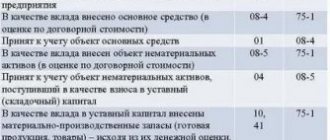Accounting
The founder reflects his contribution to the authorized capital of other organizations in account 58 “Financial investments”. You can use account 76 to reflect settlements with a subsidiary, or you can immediately reflect all settlements on account 58 without using account 76.
Debit 58.1 Credit 76 subaccount “Settlements on contributions to the authorized capital” - reflects the debt on the contribution to the capital of another organization.
The disposal of a fixed asset and its transfer to the management company is reflected as follows:
Debit 01 subaccount “Disposal of fixed assets” Credit 01
– the original (replacement) cost of the fixed asset is written off.
Debit 02 Credit 01 subaccount “Disposal of fixed assets”
– the amount of accrued depreciation is written off.
Debit 76 subaccount “Calculations for contributions to the authorized capital” Credit 01 subaccount “Disposal of fixed assets” or Debit 58.1 Credit 01 subaccount “Disposal of fixed assets” - reflects the transfer of an asset as a contribution to the authorized capital (at residual value).
If the residual value of the fixed assets does not coincide with the assessment of the founders, then the difference is taken into account as part of other income or expenses.
Debit 76 subaccount “Settlements on contributions to the authorized capital” Credit 91.1
or
Debit 58.1 Credit 91.1 - reflects the positive difference between the assessment of the fixed assets agreed upon by the founders and its residual value.
Debit 91.2 Credit 76 subaccount “Settlements for contributions to the authorized capital”
or
Debit 91.2 Credit 58 - reflects the negative difference between the assessment of the fixed assets agreed upon by the founders and its residual value.
Initial OS cost
When forming the initial cost, take into account the monetary value of the fixed asset, agreed upon by the founders (participants, shareholders) (clause 9 of PBU 6/01). This indicator should not exceed the market value of the property, determined by an independent appraiser:
- in joint stock companies;
- in an LLC, if the participant’s share in the authorized capital, which is paid for with fixed assets, exceeds 20,000 rubles.
This procedure follows from the provisions of paragraph 3 of Article 34 of the Law of December 26, 1995 No. 208-FZ and paragraph 2 of Article 15 of the Law of February 8, 1998 No. 14-FZ. In these cases, an independent assessment of property contributions to the authorized capital is mandatory.
In addition, in the initial cost of a fixed asset, include the organization’s associated costs associated with obtaining property and bringing it to a state suitable for use (for example, costs of delivery, installation, appraiser services, etc.) (clauses 8 and 12 of PBU 6/01). A detailed list of such expenses is given in the table.
During the operation of a fixed asset, its initial cost does not change. The exceptions are cases of completion (retrofitting), reconstruction, modernization, partial liquidation and revaluation of fixed assets. This procedure follows from paragraph 14 of PBU 6/01.
The procedure for determining the initial cost of fixed assets contributed as a contribution to the authorized capital differs in accounting and tax accounting. As a result, a permanent difference may arise in accounting (clause 4 of PBU 18/02). For example, this will happen if the value of the fixed asset, according to an independent assessment, is less than the residual value of the object according to the tax accounting data of the transferring party (founder).
To receive incoming fixed assets, an organization should create a commission that should determine:
- whether the fixed asset meets the technical specifications and whether it can be put into operation;
- whether it is necessary to bring (rework) the fixed asset to a state suitable for use.
If the organization's staff consists only of a director, do not create a commission. In this case, its functions must be assumed by the director.
This procedure follows from the instructions approved by Resolution of the State Statistics Committee of Russia dated January 21, 2003 No. 7.
After examining the received property, the commission must give an opinion on the possibility of its use. This conclusion is reflected in the act in form No. OS-1.
Tax accounting
VAT
VAT is not charged on fixed assets transferred to the authorized capital, since this operation is not recognized as a sale.
Input VAT on fixed assets, previously accepted for deduction, must be restored. But not all, but a part proportional to the residual value of the OS.
Debit 19 Credit 68 subaccount “Calculations for VAT” – VAT on fixed assets transferred as a contribution to the management company has been restored;
The transferring party includes the recovered VAT in the initial cost of the financial investment.
Debit 58.1 Credit 19 – restored VAT is reflected as part of financial investments.
The receiving party can accept the restored VAT as a deduction.
Income tax
When transferring property to the authorized capital of organizations, no income or expenses arise.
A loss from the contribution of fixed assets to the authorized capital of another organization does not reduce the taxable profit of the organization. If the residual value differs from the agreed valuation of the founders, then permanent differences arise.
The positive difference between the residual value and the founders’ assessment forms a permanent tax asset:
Debit 68 subaccount “Calculations for income tax” Credit 99 subaccount “Permanent tax assets”.
The negative difference between the residual value and the founders’ assessment forms a permanent tax liability:
Debit 99 subaccount “Fixed tax liabilities” Credit 68 subaccount “Calculations for income tax”.
OS contribution to the authorized capital
When forming the authorized capital, the founders can contribute their share in it with various property: cash, materials, goods, fixed assets. Let’s look at how to take into account the contribution of the operating system to the authorized capital.
Based on clause 9 of PBU 6/01 “Accounting for fixed assets,” the initial cost of fixed assets contributed to the contribution to the authorized capital is their monetary value, agreed upon by all founders.
In the 1C Accounting program 8th edition. 3.0 the OS contribution to the authorized capital is reflected in several transactions.
First, an entry is made for the formation of the authorized capital: Dt 75.01 Kt 80
In our example, the contribution is made to a limited liability company, so subaccount 09 “Other capital” is used. In the program, this transaction is generated using the operation BU and NU (operation entered manually).
The transaction indicates the name, accounts, subaccount and amount.
Next, you need to reflect the receipt of fixed assets. This can be done using another accounting and tax accounting operation, or using the document “Receipt of goods and services” with the type of operation “Equipment”. It is best to generate this document from the “Fixed Assets and Intangible Assets” tab. There it is called “Equipment Receipt” and opens immediately at the required operation.
In the document, on the “Settlement Accounts” tab, you need to indicate the accounting account for settlements with the counterparty 75.01.
According to the document, a posting is generated: Dt 08.04 Kt 75.01
Next, we formalize the acceptance of fixed assets for accounting using a document of the same name. Located on the “Fixed assets and intangible assets” tab.
The document indicates the fixed asset and adds a new one to the “Fixed Assets” directory. Data for calculating depreciation for accounting and tax purposes are also indicated.
If the transferring party restores VAT on account of the contribution to the authorized capital, the receiving party deducts it.
Based on letter No. 07-05-06/302 of the Ministry of Finance of Russia dated December 19, 2006, the amount of VAT on fixed assets accepted as a contribution to the authorized capital is subject to
tax deduction from the receiving party and is reflected in the debit of the tax account
added value and credit account additional capital.
To generate the posting Dt 19.01 Kt 83.09, an accounting and tax accounting operation is performed in the program.
Further, this VAT can be deducted on the basis of paragraph 3 of Article 170 of the Tax Code of the Russian Federation. In the program, this operation can be formalized with the document “Reflection of VAT for deduction,” which is done on the basis of the previously generated document “Receipt of goods and services.”
The wiring will be formed here: Dt 68.02 Kt 19.01
So in the 1C Accounting program 8th edition. 3.0 reflects the OS contribution to the authorized capital; see here for the general procedure for accounting for authorized capital.
Did you like the article? Share on social media networks
Case Study
Medea LLC contributed a laptop to the authorized capital of Les LLC. The agreed monetary value of the founders is 40,000 rubles.
The initial cost of the laptop is 76,700 rubles. (including VAT - 11,700 rubles). The amount of accrued depreciation is RUB 32,500.
Solution:
- Debit 01 subaccount “Disposal of fixed assets” Credit 01 - 65,000 rub. (76,700 - 11,700) - the initial cost of the laptop has been written off.
- Debit 02 Credit 01 subaccount “Disposal of fixed assets” - 32,500 rubles. — accrued depreciation is written off.
- Debit 58.1 Credit 01 subaccount “Disposal of fixed assets” - 32,500 rubles. (65,000 - 32,500) - the residual value of the laptop has been written off.
- Debit 19 Credit 68 - 5,850 rub. ((32,500: 65,000) x 11,700) — VAT has been restored.
- Debit 58.1 Credit 19 - 5,850 rub. the restored VAT is taken into account as part of financial investments.
- Debit 58.1 Credit 91.1 - 7,500 rub. (40,000 - 32,500) - reflects the positive difference between the founders’ assessment and the residual value of the laptop.
- Debit 68 Credit 99 - 1,500 rub. (7,500 x 20%) - a permanent tax asset is reflected.
Contribution to uk main means of posting
In accordance with PBU 10/99 clause 3, the disposal of assets when making contributions to the management capital of other organizations, the acquisition of shares of joint-stock companies and other securities not for the purpose of resale are not recognized as expenses of the organization.
We recommend reading: Putin's New Decree on Pensions 2021
Fixed assets transferred as a contribution to the authorized capital of other organizations are written off at their residual value to the debit of account 58 “Financial investments”. The difference between the agreed upon assessment of the contribution (which should be reflected in account 58) and the residual value of the fixed asset transferred as a contribution to the management company is reflected in account 91 “Other income and expenses” as operating income and expenses. The difference between the agreed contribution assessment () and the residual value of the fixed asset () is reflected by posting:
Increase in CV due to additional contribution of the transaction participant
All these decisions must be made unanimously by the participants (founder) of the company. After the decision to increase the authorized capital is made, the participant (participants) of the company or a third party (third parties) make their contributions.
VAT When making an additional contribution to the authorized capital, the transferring party must restore the VAT on the transferred property, and the receiving party can accept the amount of the restored tax as a deduction. At the same time, do not take into account the amount of VAT accepted for deduction when determining the tax base for income tax as part of income.
Transfer of fixed assets as a deposit in the company: accounting and taxes
One of the main tasks of creating an organization is the formation of authorized capital. The founders can pay for their share in the formed authorized capital of the company not only with money, but also with property, in particular fixed assets. However, in this case, the procedure for processing transactions will be much more complicated. If you consider this option to be the most optimal, then from this article you will learn how to estimate the value of such property, as well as the aspects of accounting and tax accounting when carrying out such transactions.
At the same time, the inclusion of fixed assets in the authorized capital gives rise to the obligation of the recipient organization to provide counter performance. The ultimate goal of the founder is to obtain economic benefits from participation in a legal entity, which will be directly proportional to the size of the contribution made. Is it possible to talk about gratuitous receipt in this case? Arbitration practice in this regard has not yet developed; let us hope that over time a different assessment of this phenomenon will be presented that does not classify a contribution to the authorized capital as a gratuitous receipt of property. In the meantime, if the organization does not want to enter into litigation, it is better not to apply a depreciation bonus to fixed assets received as a contribution to the authorized capital.
Contribution to the property of a subsidiary by fixed assets
When a company receives a fixed asset, when calculating income tax, it does not take its value into account in income x clause. 3 p. 1 art. 251 Tax Code of the Russian Federation. VAT recovered by the participant under OS is also not taken into account in income. 3.1 clause 1 art. 251 Tax Code of the Russian Federation.
We recommend reading: Kaliningrad why there are no preferential medications for cancer patients
“If an organization receives a fixed asset as a contribution to the authorized capital, such fixed assets must be taken into account as depreciable property and its value must be written off through the depreciation mechanism, even if the residual value of this property does not exceed 40,000 rubles.





